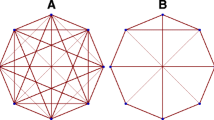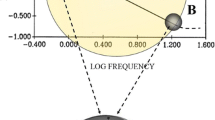Abstract
Neuroscientists are able to detect physical changes in information entropy in the available neurodata. However, the information paradigm is inadequate to describe fully nervous dynamics and mental activities such as perception. This paper suggests explanations to neural dynamics that provide an alternative to thermodynamic and information accounts. We recall the Banach–Tarski paradox (BTP), which informally states that when pieces of a ball are moved and rotated without changing their shape, a synergy between two balls of the same volume is achieved instead of the original one. We show how and why BTP might display this physical and biological synergy meaningfully, making it possible to model nervous activities. The anatomical and functional structure of the central nervous system’s nodes and edges makes it possible to perform a sequence of moves inside the connectome that doubles the amount of available cortical oscillations. In particular, a BTP-based mechanism permits scale-invariant nervous oscillations to amplify and propagate towards widely separated brain areas. Paraphrasing the BTP’s definition, we could state that: when a few components of a self-similar nervous oscillation are moved and rotated throughout the cortical connectome, two self-similar oscillations are achieved instead of the original one. Furthermore, based on topological structures, we illustrate how, counterintuitively, the amplification of scale-free oscillations does not require information transfer.

Modified from: Allen and Triantaphillidou (2009)




Modified from: https://wiki.biac.duke.edu/biac:analysis:resting_pipeline
Similar content being viewed by others
References
Alexandroff, P. (1932, 1961). Elementary concepts of topology. New York: Dover Pubs Inc. ISBN 0-486-60747-X.
Ali, A., Rafique, H., Arshad, T., Alqarni, M. A., Chauhdary, S. H., & Bashir, A. K. (2019). A fractal-based authentication technique using Sierpinski triangles in smart devices. Sensors (Basel). https://doi.org/10.3390/s19030678
Allen, E., & Triantaphillidou, S. (2009). The Manual of Photography (10th ed.). Abdingdon, Oxon: Taylor and Francis Group.
Atmanspacher, H. (2016). On macrostates in complex multi-scale systems. Entropy, 18(12), 426. https://doi.org/10.3390/e18120426
Attwell, D., & Laughlin, S. B. (2001). An energy budget for signaling in the grey matter of the brain. Journal of Cerebral Blood Flow and Metabolism, 21(10), 1133–1145. https://doi.org/10.1097/00004647-200110000-00001
Banach, S., & Tarski, A. (1924). Sur la décomposition des ensembles de points en parties respectivement congruentes. Fundamenta Mathematicae, 6, 244–277.
Bekenstein, J. D. (2003). Black holes and information theory. arXiv:quant-ph/0311049.
Bromiley, P. A., Thacker, N. A., & Bouhova-Thacker, E. (2010). Shannon entropy, Renyi entropy, and information. Tina 2004-004, Statistic and Inf Series, Imaging Sci. and Biomed. Eng., Univ. of Manchester, UK
Aliprantis, C. D., & Border, K. C. (2006). Odds and Ends. Berlin: Springer. ((ISBN-10 3-540-29586-0)).
Cafaro, C., Ali, S. A., & Giffin, A. (2016). Thermodynamic aspects of information transfer in complex dynamical systems. Physical Review E, 2016(93), 022114.
Churkin, V. A. (2010). A continuous version of the Hausdorff–Banach–Tarski paradox. Algebra and Logic, 49(1), 81–89. https://doi.org/10.1007/s10469-010-9080-y
de Arcangelis, L., & Herrmann, H. J. (2010). Learning as a phenomenon occurring in a critical state. Proceedings of the National Academy of Sciences, 107, 3977–3981.
Don, A. P., Peters, J. F., Ramanna, S., & Tozzi, A. (2020). Topological view of flows inside the BOLD spontaneous activity of the human brain. Frontiers in Computational Neuroscience. https://doi.org/10.3389/fncom.2020.00034
Fox, M. D., & Raichle, M. E. (2007). Spontaneous fluctuations in brain activity observed with functional magnetic resonance imaging. Nature reviews. Neuroscience, 8, 700–711.
Friston, K. (2010). The free-energy principle: A unified brain theory? Nature Reviews Neuroscience, 11(2), 127–138. https://doi.org/10.1038/nrn2787
Furstenberg, H. (1967). Disjointness in ergodic theory, minimal sets, and a problem in diophantine approximation. Mathematical Systems Theory, 1, 1–49.
Glasner, E., & Weiss, B. (2018). On the disjointness property of groups and a conjecture of Furstenberg. arXiv:quant-ph/0311049.
Glasner, E., Tsankov, T., Weiss, B., & Zucker, A. (2019) Bernoulli disjointness. arXiv:quant-ph/0311049.
Jaynes, E. T. (1957). Information theory and statistical mechanics. Physical Review, 106, 620.
Kantor, F. W. (1977). Information Mechanics. Hoboken: Wiley.
Kawe, T. N. J., Shadli, S. M., & McNaughton, N. (2019). Higuchi’s fractal dimension, but not frontal or posterior alpha asymmetry, predicts PID-5 anxiousness more than depressivity. Scientific Reports, 9(1), 19666. https://doi.org/10.1038/s41598-019-56229-w
Lloyd, S. (2000). Ultimate physical limits to computation. Nature, 406, 1047–1054. https://doi.org/10.1038/35023282
Lübeck, S. (2004). Universal scaling behavior of non-equilibrium phase transitions. International Journal of Modern Physics B, 18, 3977–4118.
Mandelbrot, B. (1967). How long is the coast of Britain? Statistical self-similarity and fractional dimension. Science, 56(3775), 636–638.
Marzuoli, A., & Rasetti, M. (2005). Computing spin networks. Annals of Physics, 318, 345–407.
Milstein, J., Mormann, F., Fried, I., & Koch, C. (2009). Neuronal shot noise and Brownian 1/f2 behavior in the local field potential. PLoS ONE, 4(2), e4338. https://doi.org/10.1371/journal.pone.0004338
Ỏzgủr, N., Taş, N., & Peters, J. F. (2020). New complex-valued activation functions. An International Journal of Optimization and Control Theories & Applications, 10(1), 66–72. https://doi.org/10.11121/ijocta.01.2020.00756
Özgür, N., & Taş, N. (2019). Pata Zamfirescu type fixed-disc results with a proximal application. arXiv:quant-ph/0311049.
Papo, D. (2014). Functional significance of complex fluctuations in brain activity: From resting state to cognitive neuroscience. Frontiers in Systems Neuroscience, 8, 112.
Peron, S., Pancholi, R., Voelcker, B., Wittenbach, J. D., Ólafsdóttir, H. F., et al. (2020). Recurrent interactions in local cortical circuits. Nature, 579(7798), 256–259. https://doi.org/10.1038/s41586-020-2062-x ((Epub 2020 Mar 4)).
Peters, J. F. (2018). Proximal vortex cycles and vortex nerves. Non-concentric, nesting, possibly overlapping homology cell complexes. Journal of Mathematical Sciences and Modelling, 1(2), 80–85.
Peters, J. F. (2019). Vortex nerves and their proximities. Nerve Betti numbers and descriptive proximity. Bulletin of The Allahabad Mathematical Society, 34(2), 263–276.
Peters, J. F. (2020). Computational geometry, topology and physics of digital images with applications. Shape complexes, optical vortex nerves and proximities. Cham: Springer.
Pritchard, W. S. (1992). The brain in fractal time: 1/f-like power spectrum scaling of the human electroencephalogram. The International Journal of Neuroscience, 66, 119–129.
Reese, T. M., Brzoska, A., Yott, D. T., & Kelleher, D. J. (2012). Analyzing self-similar and fractal properties of the C. elegans neural network. PLoS ONE, 7(10), e40483. https://doi.org/10.1371/journal.pone.0040483
Sengupta, B., & Stemmler, M. B. (2014). Power consumption during neuronal computation. Proceedings of the IEEE, 102, 738–750.
Shannon, C. E. (1948). A mathematical theory of information. The Bell System Technical Journal, 27, 379–423.
Sporns, O. (2006). Small-world connectivity, motif composition, and complexity of fractal neuronal connections. Biosystems, 85(1), 55–64. https://doi.org/10.1016/j.biosystems.2006.02.008
Tinker, J., & Velazquez, J. L. (2014). Power law scaling in synchronization of brain signals depends on cognitive load. Frontiers in Systems Neuroscience, 8, 73. https://doi.org/10.3389/fnsys.2014.00073
Tozzi, A., & Peters, J. F. (2016). A topological approach unveils system invariances and broken symmetries in the brain. Journal of Neuroscience Research, 94(5), 351–365. https://doi.org/10.1002/jnr.23720
Tozzi, A., & Peters, J. F. (2017). From abstract topology to real thermodynamic brain activity. Cognitive Neurodynamics, 11(3), 283–292. https://doi.org/10.1007/s11571-017-9431-7
Tozzi, A., Peters, J. F., & Cankaya, M. N. (2018). The informational entropy endowed in cortical oscillations. Cognitive Neurodynamics, 12(5), 501–507. https://doi.org/10.1007/s11571-018-9491-3
Tozzi, A., & Papo, D. (2020). Projective mechanisms subtending real world phenomena wipe away cause effect relationships. Progress in Biophysics and Molecular Biology, 151, 1–13. https://doi.org/10.1016/j.pbiomolbio.2019.12.002
Tozzi, A., & Peters, J. F. (2020). A topological approach to infinity in physics and biophysics. Foundations of Science. https://doi.org/10.1007/s10699-020-09674-0
Van den Heuvel, M. P., & Sporns, O. (2011). Rich-club organization of the human connectome. Journal of Neuroscience, 31, 15775–15786. https://doi.org/10.1523/JNEUROSCI.3539-11.2011
Wheeler, J. A. (1990). Information, physics, quantum: The search for links. In W. H. Zurek (Ed.), Complexity, Entropy, and the Physics of Information. Redwood City: Addison-Wesley.
Watanabe, T., Hirose, S., Wada, H., Imai, Y., Machida, T., et al. (2013). A pairwise maximum entropy model accurately describes resting-state human brain networks. Nature Communications, 4, 1370. https://doi.org/10.1038/ncomms2388
Watanabe, T., Kan, S., Koike, T., Misaki, M., Konishi, S., et al. (2014). Network-dependent modulation of brain activity during sleep. NeuroImage, 98, 1–10. https://doi.org/10.1016/j.neuroimage.2014.04.079
Author information
Authors and Affiliations
Corresponding author
Additional information
Publisher's Note
Springer Nature remains neutral with regard to jurisdictional claims in published maps and institutional affiliations.
Rights and permissions
About this article
Cite this article
Tozzi, A., Peters, J.F. Information-devoid routes for scale-free neurodynamics. Synthese 199, 2491–2504 (2021). https://doi.org/10.1007/s11229-020-02895-7
Received:
Accepted:
Published:
Issue Date:
DOI: https://doi.org/10.1007/s11229-020-02895-7




